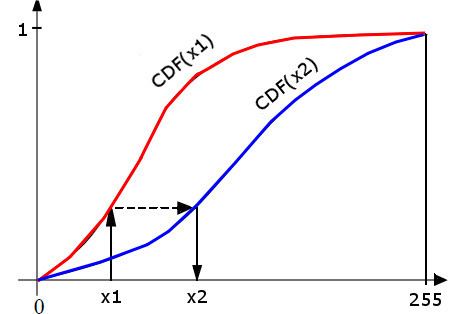 | ||
In image processing, histogram matching or histogram specification is the transformation of an image so that its histogram matches a specified histogram. The well-known histogram equalization method is a special case in which the specified histogram is uniformly distributed.
Contents
It is possible to use histogram matching to balance detector responses as a relative detector calibration technique. It can be used to normalize two images, when the images were acquired at the same local illumination (such as shadows) over the same location, but by different sensors, atmospheric conditions or global illumination.
Algorithm
Given two images, the reference and the adjusted images, we compute their histograms. Following, we calculate the cumulative distribution functions of the two images' histograms –
Exact histogram matching
In typical real-world applications, with 8-bit pixel values (discrete values in range [0, 255]), histogram matching can only approximate the specified histogram. All pixels of a particular value in the original image must be transformed to just one value in the output image.
Exact histogram matching is the problem of finding a transformation for a discrete image so that its histogram exactly matches the specified histogram. Several techniques have been proposed for this. One simplistic approach converts the discrete-valued image into a continuous-valued image and adds small random values to each pixel so their values can be ranked without ties. However, this introduces noise to the output image.
Multiple histogram matching
The histogram matching algorithm can be extended to find a monotonic mapping between two sets of histograms. Given two sets of histograms
